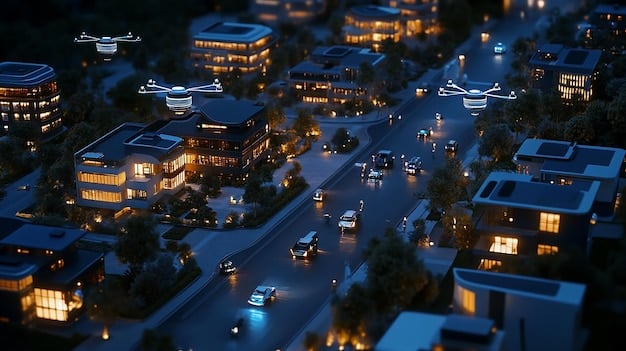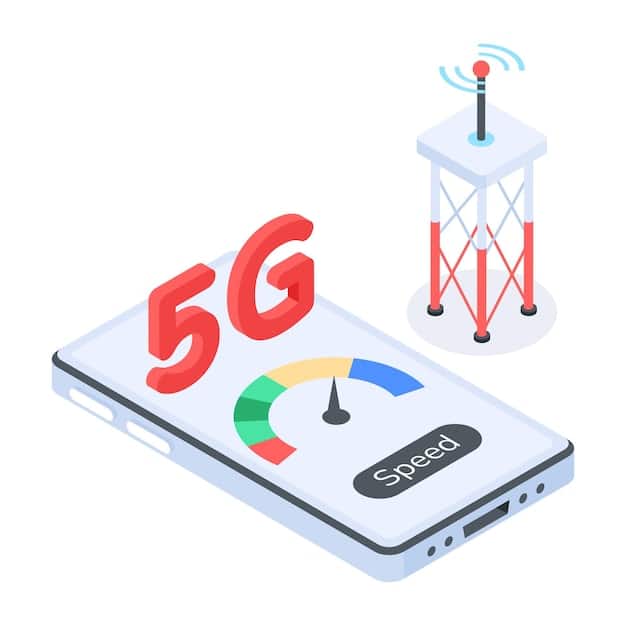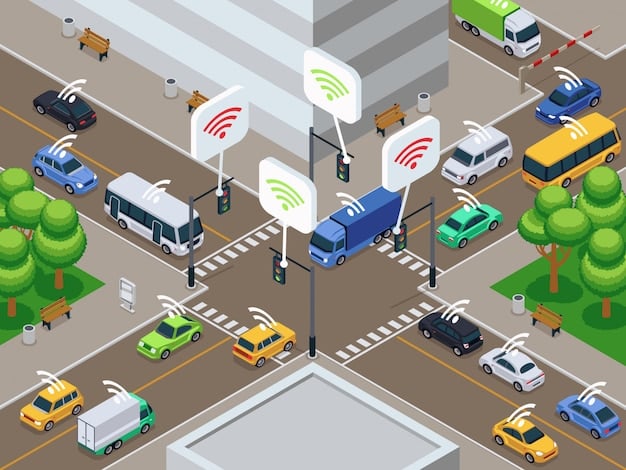5G Expansion in the US: Impacts on IoT Device Manufacturers

5G expansion in the US brings faster speeds and lower latency, enabling IoT device manufacturers to create more advanced products and services, but also presents challenges in terms of security and compatibility.
The 5G Expansion in the US: What It Means for IoT Device Manufacturers is a transformative shift, promising to unlock unprecedented opportunities and introduce new challenges for the industry.
Understanding the 5G Revolution and its Reach
5G technology is more than just an incremental upgrade over 4G. It represents a fundamental shift in wireless communication capabilities, offering significantly higher speeds, lower latency, and greater network capacity. Understanding these core improvements is crucial to grasping the implications for IoT device manufacturers.
Key Benefits of 5G for IoT
5G’s advantages extend far beyond faster downloads on smartphones. Its ability to support a massive number of connected devices simultaneously, with near-real-time responsiveness, opens new avenues for IoT innovation.
- Enhanced Speed: 5G’s higher data transfer rates enable IoT devices to transmit and receive larger amounts of data more quickly, facilitating applications like high-resolution video streaming and real-time data analytics.
- Reduced Latency: Lower latency minimizes delays in communication between devices and servers, which is critical for applications requiring immediate responses, such as autonomous vehicles and industrial automation.
- Increased Capacity: 5G networks can support a much higher density of connected devices compared to 4G, making it possible to deploy large-scale IoT networks in smart cities, factories, and other environments.
The expansion of 5G infrastructure across the US is laying the groundwork for a more connected and intelligent future. This improved connectivity is not just incremental; it will allow for entirely new types of IoT deployments.

Impact on IoT Device Design and Functionality
The capabilities of 5G are influencing how IoT devices are designed and the functionalities they can offer. Manufacturers are now able to create more sophisticated and data-intensive devices, driving innovation across various sectors.
Enhanced Data Processing
With 5G, IoT devices can generate and transmit massive amounts of real-time data, which can be processed and analyzed to provide valuable insights.
The quicker data transfer of 5G enables complex data processing tasks to be performed more efficiently. This allows IoT devices to analyze information on the fly, leading to smarter and more responsive systems.
Remote Management and Control
5G makes it easier to manage and control IoT devices remotely, enabling manufacturers and users to monitor and adjust device settings from anywhere with an internet connection.
- Over-the-Air (OTA) Updates: 5G facilitates faster and more reliable OTA updates, allowing manufacturers to push software updates and security patches to IoT devices without requiring physical access.
- Remote Diagnostics: 5G connectivity enables remote diagnostics and troubleshooting, reducing downtime and maintenance costs for businesses that rely on IoT devices.
- Real-Time Control: The low latency of 5G enables applications that require real-time control, such as remote surgery and drone-based delivery services.
These advancements open up new possibilities for IoT device manufacturers, enabling them to create products that are more reliable, efficient, and user-friendly.
Opportunities in Smart Cities and Infrastructure
Smart cities represent a significant opportunity for IoT device manufacturers, driven by the need for interconnected systems that improve efficiency, sustainability, and quality of life. 5G plays a vital role in enabling these smart city initiatives.
5G is creating chances for improved infrastructure and optimized resource use. By harnessing IoT devices, cities can use data-driven decision-making and create sustainable and efficient environments.
Smart City Applications
The possibilities that 5G enables in smart cities are massive, including better traffic management systems, optimized energy grids, and public safety enhancements.
Improved city operations and resident experiences are the key outcomes of leveraging IoT to collect and analyze real-time data.
- Smart Transportation: 5G-enabled IoT devices can be used to monitor traffic patterns, optimize traffic flow, and provide real-time information to commuters. This can help reduce congestion, improve air quality, and enhance the overall commuting experience.
- Smart Energy: IoT sensors and smart meters can be deployed to monitor energy consumption, identify inefficiencies, and optimize energy distribution. This can help reduce energy waste, lower energy costs, and promote sustainability.
- Smart Waste Management: IoT sensors can be used to monitor waste levels in bins and containers, optimize collection routes, and reduce waste disposal costs. This can help improve sanitation, reduce pollution, and promote recycling.
By actively participating in smart city projects, IoT device manufacturers can create valuable solutions and generate major revenue streams.

Transforming Industrial IoT (IIoT) with 5G
Industrial IoT (IIoT) is poised to undergo a profound transformation with the widespread adoption of 5G. The ability to connect countless sensors, machines, and systems within industrial environments opens new doors for automation, efficiency, and predictive maintenance.
5G is establishing a new paradigm for IIoT, leading to considerable improvements in production processes, operational efficiency, and real-time decisioning.
Key IIoT Applications
As 5G makes its way into industrial settings, companies can anticipate considerable advancements in areas such as automated production lines and real-time monitoring of equipment.
The convergence of 5G and IIoT offers prospects that guarantee reduced expenses, streamlined workflows, and elevated levels of operational safety.
- Predictive Maintenance: IoT sensors can be used to monitor the condition of equipment and predict when maintenance will be required. This can help prevent breakdowns, reduce downtime, and extend the lifespan of equipment.
- Real-Time Monitoring: 5G connectivity enables real-time monitoring of industrial processes, allowing operators to identify and address issues as they arise. This can help improve efficiency, reduce waste, and enhance safety.
- Remote Robotics: 5G’s low latency makes it possible to control robots remotely, enabling applications such as remote inspections, repairs, and hazardous materials handling.
IoT device manufacturers who prioritize IIoT-based solutions are best positioned to capitalize on 5G deployments in industrial areas.
Challenges and Security Considerations
While 5G offers significant advantages for IoT device manufacturers, it also presents challenges that need to be addressed, particularly regarding security and compatibility.
Security Risks
As IoT devices become more interconnected and rely on 5G for communication, they also become more vulnerable to cyberattacks. It’s crucial for manufacturers to prioritize security in their device design and development processes.
Ensuring the confidentiality, integrity, and availability of IoT systems necessitates the implementation of strict security procedures at the device level as well as throughout the network.
Manufacturers must be mindful of the following security threats:
- Data Breaches: Sensitive data transmitted by IoT devices can be intercepted and stolen by malicious actors if not properly encrypted and protected.
- Denial-of-Service (DoS) Attacks: Hackers can flood IoT devices with traffic, preventing them from functioning properly and disrupting services.
- Malware Infections: IoT devices can be infected with malware, which can be used to steal data, control the device remotely, or launch attacks against other devices.
Proactive safety steps, such as routine security audits and firmware updates, are critical to counter these risks.
Preparing for the Future: Strategies for IoT Manufacturers
To succeed in the 5G era, IoT device manufacturers need to adopt proactive strategies that enable them to harness the benefits of the technology while mitigating the associated risks.
Strategic Recommendations
To maximize the impact of 5G, manufacturers must concentrate on interoperability, security, and innovation.
Smart investments in research and development, strategic alliances, and agile production methods can enable manufacturers to adjust quickly to the evolving demands of the marketplace.
- Invest in 5G-enabled technologies: Manufacturers should invest in developing IoT devices that are specifically designed to take advantage of 5G’s capabilities, such as higher speeds, lower latency, and increased capacity.
- Prioritize security: Security should be a top priority throughout the device design and development process. Manufacturers should implement robust security measures to protect against cyberattacks and data breaches.
- Collaborate with industry partners: Collaboration with other companies in the 5G and IoT ecosystems can help manufacturers develop innovative solutions and expand their market reach.
Manufacturers that promote creative solutions, prioritize safety, and forge strategic connections are certain to flourish in the era of 5G.
| Key Aspect | Brief Description |
|---|---|
| 🚀 Enhanced Speed | 5G offers significantly higher data transfer rates compared to 4G. |
| ⚙️ Reduced Latency | 5G’s lower latency is critical for real-time IoT applications. |
| 🛡️ Security Risks | Increased connectivity brings new security vulnerabilities to IoT devices. |
| 🏭 IIoT Transformation | 5G revolutionizes industrial IoT with enhanced automation and monitoring. |
Frequently Asked Questions
▼
5G offers enhanced speed, reduced latency, and increased capacity, enabling IoT devices to transmit more data faster, respond in real-time, and support a higher density of connections.
▼
5G enhances smart city applications like traffic management, energy distribution, and waste management by providing reliable, high-speed connectivity for numerous IoT sensors and devices.
▼
Security concerns include data breaches, denial-of-service attacks, and malware infections. Robust security measures, firmware updates, and audits are crucial to mitigate these risks.
▼
5G enables predictive maintenance, real-time monitoring, and remote robotics in IIoT environments, enhancing automation, efficiency, and safety in industrial operations.
▼
Manufacturers should invest in 5G-enabled technologies, prioritize security in device design, and collaborate with industry partners to develop innovative solutions and expand market reach.
Conclusion
The expansion of 5G in the US presents both significant opportunities and challenges for IoT device manufacturers. By embracing 5G’s capabilities and addressing its security implications, manufacturers can unlock new possibilities for innovation and growth in a hyper-connected world.
